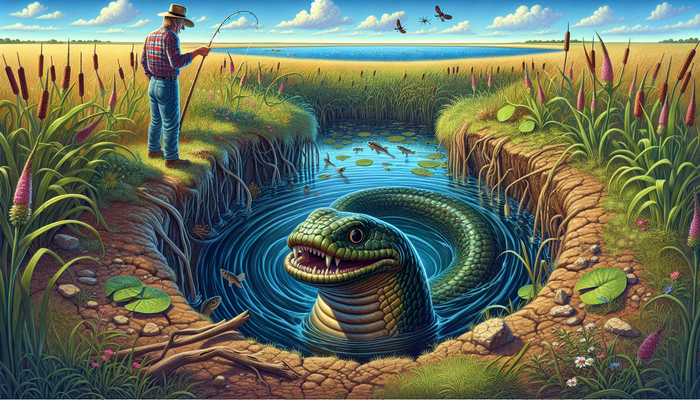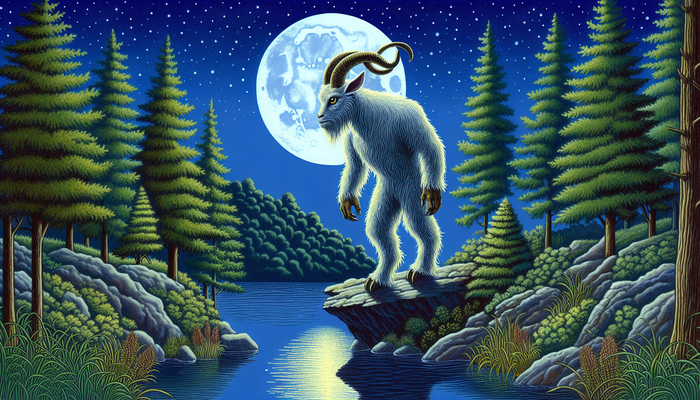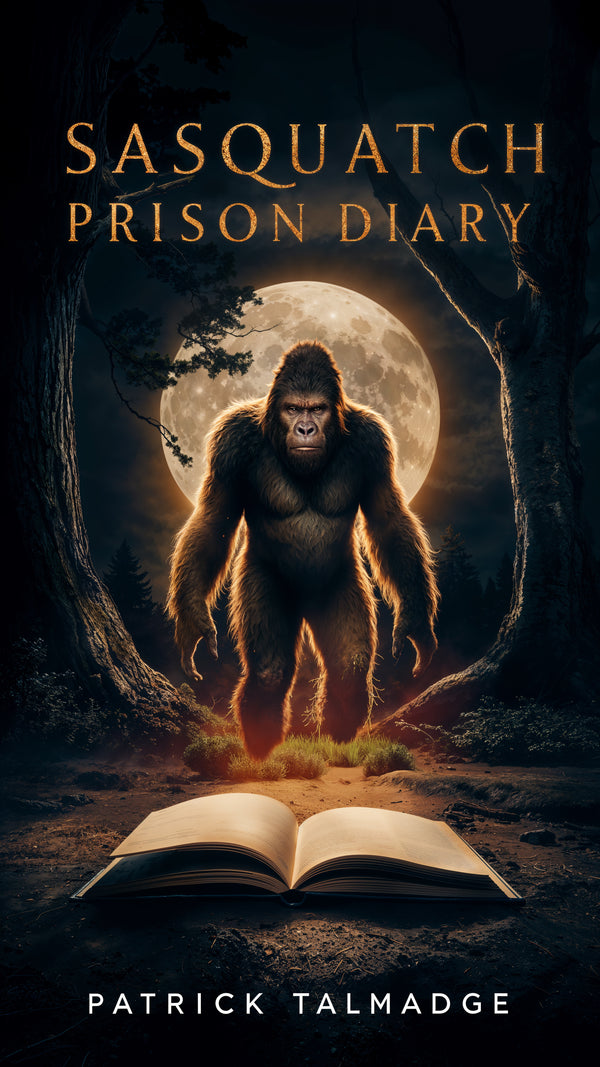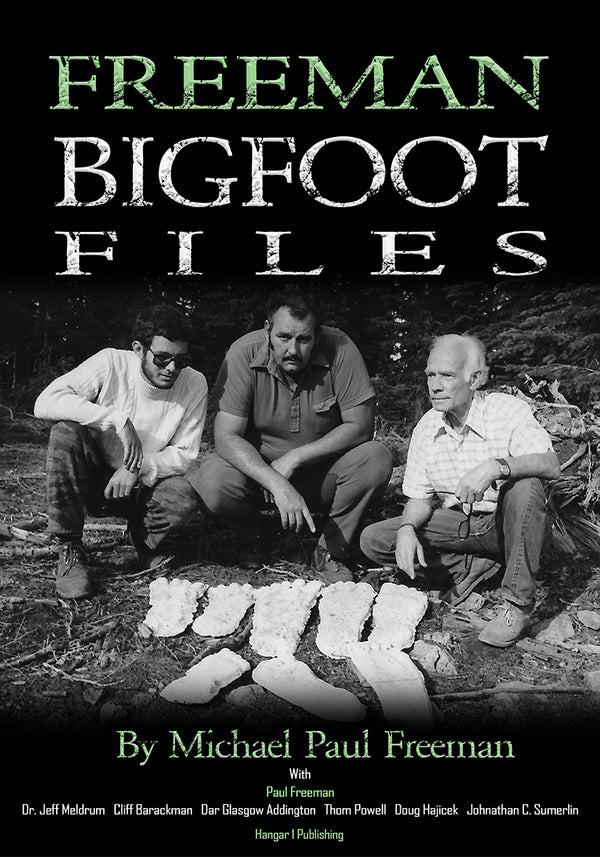The Michigan Dog Man: Unraveling the Legend of the Bipedal Beast
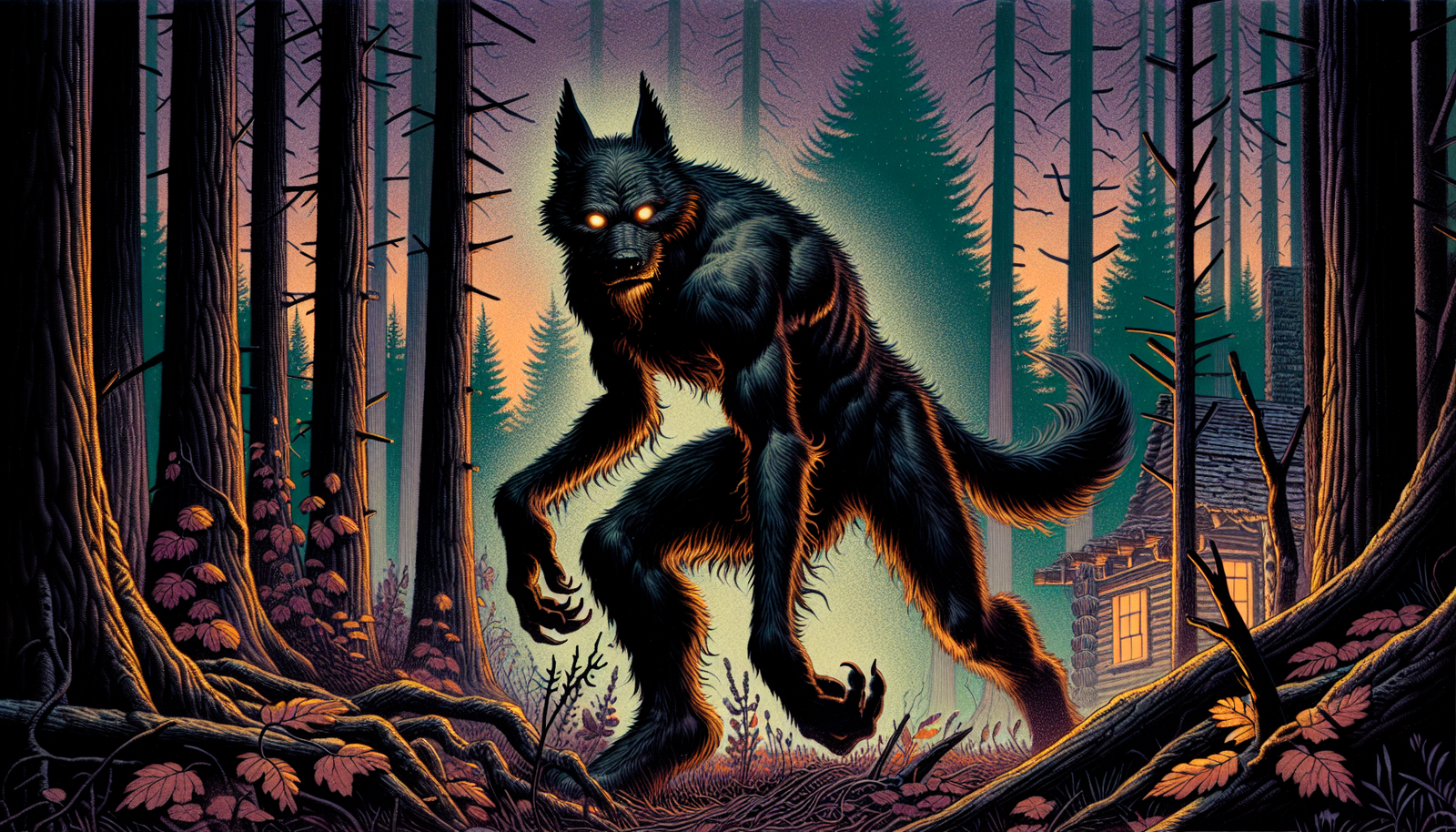
By James Roberts, Cryptozoologist
The Birth of a Legend
Our story begins in 1887, in the rugged terrain of Wexford County, Michigan. Two lumberjacks, their axes slung over their shoulders, were making their way through the woods when they stumbled upon something that would change their lives forever. There, in a clearing, stood a creature unlike anything they'd ever seen—seven feet tall, with the body of a man but the head of a dog. Its eyes, they said, glowed with an otherworldly light, and when it howled, the sound sent shivers down their spines.
This first reported sighting of the Dogman set the stage for a legend that would grow and evolve over the decades. But the lumberjacks' tale wasn't born in a vacuum. The forests of Michigan had long been home to stories of strange creatures and shapeshifters, passed down through generations of Native American tribes like the Odawa. These ancient legends spoke of beings that could transform from human to animal, blurring the lines between our world and the spirit realm.
As European settlers pushed into the Michigan wilderness, they brought their own folklore with them—tales of werewolves and other half-human, half-animal creatures. It's in this rich soil of myth and belief that the Dogman took root, growing into a uniquely American legend that combines elements of both Native and settler traditions.
The Anatomy of a Monster
So, what exactly does the Michigan Dogman look like? According to eyewitness accounts, this isn't your average cryptid. Standing at an impressive seven feet tall, the Dogman towers over most humans. Its body is muscular and covered in thick, dark fur, giving it the appearance of a bodybuilder in a very convincing dog costume. But it's the creature's head that really sets it apart—described as unmistakably canine, with a long snout, pointed ears, and teeth that would make a timber wolf jealous.
One of the most striking features of the Dogman is its eyes. Witnesses report them as glowing blue, amber, or sometimes even red, with an intelligence that seems almost human. It's these eyes that often leave the strongest impression on those who claim to have seen the creature, as if they've looked into the face of something that shouldn't exist in our world.
But it's not just the Dogman's appearance that captures the imagination—it's how it moves. Unlike your typical quadrupedal canine, the Dogman is said to be comfortable walking on two legs, giving it an eerie human-like gait. Witnesses describe it as incredibly agile, able to leap great distances and move through the forest with supernatural speed.
And then there's the howl. If you thought wolves were scary, the Dogman's vocalization is said to be in a league of its own. Described as a cross between a wolf's howl and a human scream, it's a sound that reportedly freezes the blood of those unfortunate enough to hear it. Some say it's a warning, others believe it's a call to others of its kind. Whatever the case, it's become one of the most iconic aspects of the Dogman legend.
The Ten-Year Itch: A Cycle of Sightings
One of the most intriguing aspects of the Michigan Dogman legend is the supposed cycle of its appearances. According to the lore, the creature is most active in years ending in 7—1987, 1997, 2007, and so on. This pattern has become so ingrained in the mythology that it's almost treated as gospel among Dogman enthusiasts.
But why the seven-year cycle? Some speculate it's tied to ancient lunar calendars or natural biological rhythms. Others suggest it's simply a quirk of human pattern-seeking behavior, our brains trying to make sense of random events by imposing a structure on them. Whatever the reason, this cycle has created a sense of anticipation and dread among believers, with each approaching "Dogman year" bringing a fresh wave of excitement and fear.
The most recent "Dogman year" was 2017, which saw a spike in reported sightings and renewed interest in the legend. As we approach 2027, the next year in the cycle, there's already a buzz building in cryptid-hunting circles. Will this be the year someone finally captures undeniable proof of the Dogman's existence? Or will it be another round of tantalizing glimpses and near-misses?
This cyclical nature of the legend adds an extra layer of mystique to the Dogman story. It's not just a creature that might be lurking in the woods at any time—it's a phenomenon with its own rhythm, a beast that seems to dance to the beat of some cosmic drum we can't quite hear.
The Song That Howled Around the World
In the annals of cryptid lore, few creatures can claim to have their own theme song. But the Michigan Dogman isn't your average monster, and "The Legend" isn't your average song. Created by Traverse City disc jockey Steve Cook in 1987, this catchy tune was originally intended as nothing more than an April Fool's Day prank. Little did Cook know that his musical joke would become the catalyst for a Dogman renaissance.
"The Legend" tells the story of the Dogman through the decades, recounting various sightings and encounters set to a folksy, campfire-style melody. It's the kind of song that sticks in your head, making you hum about seven-foot canines long after the last note has faded. But what really sets "The Legend" apart is what happened after it hit the airwaves.
Almost immediately, Cook's radio station was flooded with calls from listeners claiming they had seen the Dogman themselves. It was as if the song had given people permission to share experiences they'd been keeping secret for years. Suddenly, the Dogman wasn't just a vague story passed around at summer camps—it was a phenomenon with witnesses, dates, and locations.
The impact of "The Legend" on Dogman lore can't be overstated. It took a scattered collection of local myths and wove them into a coherent narrative, one that resonated with people across Michigan and beyond. The song became so popular that Cook began selling cassettes, with proceeds going to local animal shelters. In a twist of irony, a song about a monstrous canine ended up helping real dogs in need.
But "The Legend" did more than just popularize the Dogman—it standardized the mythology. Before the song, descriptions of the creature varied widely from one account to another. After "The Legend," reports began to converge on a more consistent image of what the Dogman looked like and how it behaved. It's a fascinating example of how art can shape folklore, blurring the lines between fact and fiction.
Today, "The Legend" remains a beloved part of Michigan culture, played on radio stations around Halloween and sung around campfires throughout the year. It's a reminder that sometimes, the most enduring myths are the ones we create ourselves.
Tales from the Shadows: Notable Dogman Encounters
While the Dogman may have gained widespread fame in the 1980s, reports of encounters with the creature stretch back much further. These stories, passed down through generations and whispered around campfires, form the backbone of the Dogman legend. Let's shine a flashlight on some of the most compelling accounts.
The Paris Panic of 1937
In the summer of 1937, Robert Fortney was enjoying a peaceful fishing trip along the Muskegon River near Paris, Michigan. His tranquil day took a terrifying turn when he was suddenly surrounded by a pack of wild dogs. As Fortney reached for his shotgun, ready to defend himself, something extraordinary happened. One of the dogs—larger than the others—stood up on its hind legs and fixed Fortney with an unnervingly intelligent stare.
Fortney's account is significant not just for its vivid details, but for how it bridges the gap between early Dogman lore and more modern sightings. It suggests that whatever people were encountering in the Michigan woods, it wasn't a recent phenomenon.
The Holy Terror of 1957
Twenty years after Fortney's encounter, the Dogman seemingly decided to get religion. In 1957, a local clergyman made a startling discovery at his church—deep claw marks gouged into the wooden door. What made this incident particularly chilling was the height of the marks. According to reports, they were so high up that whatever made them would have had to stand at least seven feet tall.
This incident added a new dimension to the Dogman legend. It wasn't just a creature of the deep woods anymore; it was bold enough to approach human settlements, even places of worship. The idea that not even sacred ground was safe from the Dogman sent shivers through the community.
The Night Watchman's Nightmare of 1961
Perhaps one of the most compelling pieces of evidence in the Dogman saga comes from a night watchman at a manufacturing plant in Big Rapids, Michigan. On a quiet night in 1961, the watchman was making his rounds when he spotted something moving near the property's fence line. At first, he thought it might be an intruder. But as he watched, he realized he was seeing something far stranger.
The creature he described alternated between walking on all fours and standing upright. It was covered in dark fur and moved with an unnatural agility. But here's where this story takes an interesting turn—the watchman claimed to have photographed the creature. The resulting image, while blurry, shows a large, dark figure that doesn't quite match any known animal.
This incident is particularly noteworthy because it's one of the few Dogman encounters with purported physical evidence. While the photo has been the subject of much debate and skepticism, it remains one of the most tantalizing pieces of the Dogman puzzle.
The OnStar Incident of 2006
Fast forward to the digital age, and we find the Dogman adapting to modern times. In 2006, a driver in Troy, Michigan, made a frantic call to OnStar, the in-vehicle safety and security system. The driver claimed he had swerved to avoid hitting a "great big dog standing upright" in the middle of the road, causing his car to flip over.
What makes this incident stand out is the audio recording of the call, which captures the genuine fear and confusion in the driver's voice. It's a chilling reminder that even in our age of technology and skepticism, there are still things out there that defy easy explanation.
The Gable Film Controversy
No discussion of Dogman encounters would be complete without mentioning the infamous Gable Film. Purportedly shot in the 1970s, this grainy 8mm footage appears to show a family's encounter with a large, bipedal creature in the Michigan woods. For years, it was considered by many to be the smoking gun of Dogman evidence.
However, in a twist that highlights the complex relationship between folklore and fact, the Gable Film was eventually revealed to be an elaborate hoax. Created by Mike Agrusa, a Michigan resident, the film was a testament to both the enduring power of the Dogman legend and the lengths to which some will go to perpetuate it.
While the Gable Film's debunking was disappointing to many Dogman enthusiasts, it didn't diminish the overall legend. If anything, it sparked even more interest, as people debated what other evidence might be out there waiting to be discovered—or debunked.
These encounters, from Fortney's 1937 fishing trip to the 2006 OnStar call, form a tapestry of testimony that has kept the Dogman legend alive for generations. Each story adds a new thread, weaving together a creature that's part flesh-and-blood animal, part supernatural entity, and entirely Michigan.
Dogman Goes Hollywood: Cultural Impact and Media Representation
The Michigan Dogman may have started as a local legend, but it didn't stay that way for long. As the stories spread beyond the borders of the Great Lakes State, the Dogman found its way into popular culture, becoming a star of screen, page, and internet forums.
Lights, Camera, Howl!
In 2011, filmmaker Rich Brauer decided it was time for the Dogman to make its silver screen debut. His film, aptly titled "Dogman," brought the legend to life with a mix of local lore and Hollywood flair. Starring Larry Joe Campbell, the movie premiered at the State Theater in Traverse City, Michigan—right in the heart of Dogman country.
What made "Dogman" particularly interesting was its use of the infamous Gable Film. By incorporating this piece of Dogman "evidence" into the narrative, Brauer blurred the lines between fact and fiction, much like the legend itself does. The film became a cult hit, especially among cryptid enthusiasts and Michigan locals who grew up with the Dogman stories.
But the Dogman's screen time wasn't limited to feature films. Television shows like "MonsterQuest" and "Monsters and Mysteries in America" have dedicated episodes to exploring the legend. These programs often feature interviews with alleged witnesses, analysis from cryptozoologists, and dramatic reenactments of Dogman encounters. While skeptics might roll their eyes, these shows have played a crucial role in introducing the Dogman to a national audience.
Dogman: The Merch
As with any pop culture phenomenon, it wasn't long before Dogman merchandise started appearing. T-shirts featuring artistic renderings of the creature, plush toys for the younger (or young-at-heart) cryptid fan, and even Dogman-themed beer from local Michigan breweries have all hit the market. This commercialization of the legend might seem at odds with its spooky origins, but it's actually a testament to how deeply the Dogman has embedded itself in Michigan's cultural identity.
One particularly creative piece of Dogman merch is a series of "Dogman Repellent" sprays and charms. While obviously tongue-in-cheek, these items speak to the playful way many Michiganders have embraced their local monster. It's as if by turning the Dogman into something you can wear on a t-shirt or spray on your tent, people are both celebrating and taming the legend.
Dogman Digital
In the age of the internet, the Dogman has found a new hunting ground. Numerous websites, forums, and social media groups are dedicated to discussing Dogman sightings, theories, and evidence. These online communities have become virtual campfires, where modern storytellers share their encounters and keep the legend alive.
YouTube has been particularly fertile ground for Dogman content. Channels like "Dogman Encounters Radio" and "Vic Cundiff" feature hours of interviews with people claiming to have seen the creature. While the veracity of these accounts is often questionable, they've created a new oral tradition for the digital age, allowing the Dogman story to evolve and spread in ways the original 1887 lumberjacks could never have imagined.
The Dogman has even made its way into the world of podcasts. Shows like "Monsters Among Us" and "Cryptid Creatures" regularly feature Dogman stories, analyzing the legend from various angles and introducing it to new audiences around the world.
Dogman Tourism
Perhaps the most tangible evidence of the Dogman's cultural impact can be seen in Michigan's tourism industry. Several towns in the northwestern part of the state have embraced their connection to the legend, offering Dogman-themed tours, events, and attractions.
The village of Bray Road in Wisconsin, home to a similar creature known as the Beast of Bray Road, has seen an uptick in curious visitors hoping to catch a glimpse of their local cryptid. It's not hard to imagine Michigan towns following suit, turning their Dogman connections into a unique selling point for adventurous tourists.
Some entrepreneurial individuals have even started offering "Dogman Hunting" expeditions, taking groups into the Michigan woods in search of the elusive creature. While the chances of actually encountering a Dogman are, shall we say, slim, these tours offer a thrilling way to experience the Michigan wilderness and learn about local folklore.
The Dogman legend has grown far beyond its humble origins in the logging camps of Wexford County. Through films, television, merchandise, and digital media, it has become a part of Michigan's cultural fabric, as recognizable in some circles as the state's famous mitten shape or its Great Lakes shorelines. The Dogman serves as a reminder that in our modern, interconnected world, there's still room for mystery, wonder, and just a little bit of fear.
Theories and Explanations: Making Sense of the Dogman
When confronted with a legend as persistent and widespread as the Michigan Dogman, it's natural to wonder: what's really going on here? Is there a rational explanation for all these sightings, or are we dealing with something truly unexplainable? Let's put on our detective hats and examine some of the theories that have been proposed to explain the Dogman phenomenon.
The Case of Mistaken Identity
One of the most common explanations for Dogman sightings is simple misidentification. Michigan is home to a variety of large mammals, including black bears, wolves, and coyotes. In the dim light of dusk or dawn, or in the panic of an unexpected encounter, it's not hard to imagine how one of these animals could be mistaken for something more extraordinary.
Bears, in particular, are often cited as potential Dogmen. When a bear stands on its hind legs, it can easily reach seven feet tall—matching the reported height of the Dogman. Add in the low light conditions of many sightings, and a bear's silhouette could certainly take on a more monstrous appearance.
But this theory has its critics. Many Dogman witnesses insist that what they saw was no ordinary animal. They point to the creature's ability to run on two legs for extended periods, its unusual facial features, and its eerie, human-like behaviors as evidence that they encountered something beyond the realm of known wildlife.
The Cryptid Hypothesis
For those who believe the Dogman is a real, biological entity, the next question is: what kind of creature could it be? Some cryptozoologists—researchers who study animals whose existence is unproven—have proposed that the Dogman might be a surviving population of prehistoric creatures.
One theory suggests that the Dogman could be a remnant population of Amphicyonids, also known as "bear-dogs." These were large, carnivorous mammals that lived millions of years ago and had features of both bears and dogs. While Amphicyonids are long extinct, the idea of a relict population surviving in the remote forests of Michigan is tantalizing to some Dogman enthusiasts.
Another cryptozoological theory posits that the Dogman might be a new species altogether—a type of canine that has evolved to be larger and more bipedal than its wolf ancestors. This theory often draws comparisons to Bigfoot, suggesting that the Dogman might be a "canine equivalent" to the famous ape-like cryptid.
The Psychological Perspective
Moving away from biological explanations, some researchers have suggested that the Dogman phenomenon might be more about human psychology than unknown animals. This approach looks at the Dogman as a modern manifestation of ancient fears and archetypes.
The idea of a half-man, half-beast creature is deeply rooted in human mythology, appearing in cultures around the world. From the werewolves of European folklore to the skinwalkers of Native American tradition, the concept of a human transforming into an animal (or vice versa) seems to tap into something primal in our collective psyche.
From this perspective, the Dogman might be seen as a modern incarnation of these age-old fears—a way for our minds to give shape to the unknown dangers we imagine lurking in the dark forests. The fact that Dogman sightings often occur in liminal spaces—on the edge of civilization, at twilight, or in transitional areas like roads cutting through forests—supports this psychological interpretation.
The Paranormal Possibility
For some, the strange details of many Dogman encounters—the glowing eyes, the supernatural speed and strength, the ability to appear and disappear at will—point to something beyond the physical realm. These theorists suggest that the Dogman might be a paranormal entity, perhaps a spirit or interdimensional being that can take physical form under certain conditions.
This theory often draws connections to Native American beliefs about shapeshifters and spirit animals. Some proponents argue that the Dogman is a guardian spirit of the forest, appearing to warn humans away from sacred or dangerous areas.
While this explanation veers into territory that many would consider unscientific, it's worth noting that for many witnesses, their Dogman encounters felt profoundly otherworldly. The sense of dread, the feeling of time distortion, and the overwhelming "wrongness" that many describe align closely with accounts of paranormal experiences.
The Hoax Hypothesis
No examination of the Dogman phenomenon would be complete without considering the possibility of hoaxes. The revelation that the Gable Film was a fabrication serves as a reminder that some people are willing to go to great lengths to perpetuate a myth.
Hoaxes could take many forms—from elaborate costumes and staged "sightings" to exaggerated or entirely fabricated stories. The motivations for such hoaxes might range from a desire for attention to a misguided attempt to "prove" the legend real.
However, it's important to note that while hoaxes certainly exist, they can't account for all Dogman reports. Many witnesses have nothing to gain from sharing their stories and often express reluctance to come forward, fearing ridicule or disbelief.
The Power of Suggestion
A final theory worth considering is the role of suggestion and expectation in shaping Dogman experiences. Once a person is aware of the Dogman legend, they might be more likely to interpret ambiguous stimuli—strange sounds in the woods, shadowy figures glimpsed from the corner of the eye—as evidence of the creature.
This doesn't necessarily mean that witnesses are lying or hallucinating. Rather, it suggests that our brains are constantly trying to make sense of the information we receive, and sometimes they fill in the gaps with what we expect or fear to see.
The release of "The Legend" song in 1987 and the subsequent spike in Dogman reports could be seen as evidence of this effect. By providing a detailed description of the Dogman and its habits, the song may have given people a framework for interpreting their own unusual experiences in the woods.
In the end, the true nature of the Michigan Dogman remains elusive. Each theory offers a piece of the puzzle, but none can fully explain every aspect of the phenomenon. Perhaps that's part of the legend's enduring appeal—like the creature itself, it refuses to be easily categorized or explained away.
What we can say with certainty is that the Dogman has become an integral part of Michigan's cultural landscape. Whether it's a flesh-and-blood creature, a psychological phenomenon, or something in between, the Dogman continues to captivate our imaginations and remind us that there are still mysteries in this world waiting to be unraveled.
As we look ahead to 2027—the next year in the Dogman's supposed cycle—one thing is clear: the legend of the Michigan Dogman is far from over. Whether you're a skeptic or a true believer, the next time you find yourself in the forests of Michigan, you might want to listen a little more closely to the sounds of the night. After all, you never know what might be lurking just beyond the reach of your flashlight.
The Michigan Dogman stands as a testament to the enduring power of folklore in our modern world. It's a reminder that despite our technological advances and scientific understanding, there's still room for mystery and wonder in the dark corners of our world. Whether you see the Dogman as a creature of flesh and blood, a manifestation of our collective fears, or simply a good story to tell around the campfire, its impact on Michigan's culture and identity is undeniable.
For those intrigued by the Dogman legend and eager to explore further, there are numerous resources available. Books like Linda S. Godfrey's "The Beast of Bray Road" offer in-depth explorations of the Dogman and similar creatures. Online forums and social media groups dedicated to Dogman sightings provide platforms for witnesses to share their experiences and for enthusiasts to discuss the latest theories and evidence.
But perhaps the best way to truly appreciate the Dogman legend is to experience the Michigan wilderness for yourself. Take a hike through the Manistee National Forest, camp under the stars in Wexford County, or simply drive down a lonely country road as the sun sets. Let your imagination wander, and who knows—you might just catch a glimpse of something extraordinary.
In the end, whether the Michigan Dogman is real or not almost doesn't matter. Its true power lies in its ability to spark our imagination, to make us question what we think we know about the world around us, and to remind us that sometimes, the most thrilling adventures are the ones that lead us into the unknown.
So the next time you hear a strange howl echoing through the Michigan night, or see a pair of glowing eyes watching you from the treeline, remember the legend of the Dogman. And maybe, just maybe, you'll have a story of your own to add to the legend.
From Bigfoot to UFOs: Hangar 1 Publishing Has You Covered!
Explore Untold Stories: Venture into the world of UFOs, cryptids, Bigfoot, and beyond. Every story is a journey into the extraordinary.
Immersive Book Technology: Experience real videos, sights, and sounds within our books. Its not just reading; its an adventure.


